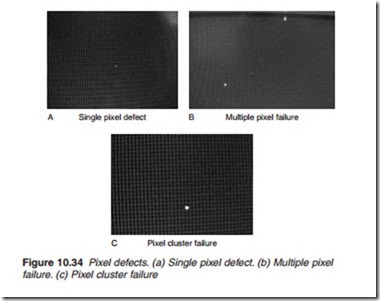Plasma panel faults
The first step in fault finding on PDP panels is to ascertain if the fault is a panel malfunction, in which case it has to be replaced, or if the cause of the fault is outside the panel in which case a repair is possible. Some of the symp- toms point clearly to a panel fault, others may be ambiguous. One of the more obvious symptoms of a faulty panel is Pixel defects. This may be a sin- gle pixel, several pixels or cluster pf pixel failure as illustrated in Figure 10.34. Manufacturers allow for a certain number of pixel defects before the panel is rendered obsolete. The display panel is divided into a central area and side areas and the number of bad pixels permitted depends on the area.
Other classic symptoms pointing to faulty PDP panel are shown in Figure 10.35. A horizontal line across the screen (Figure 10.35a) may be caused by a faulty panel or a faulty tape carrier in which case, the panel has to be replaced. However, it could also be caused by a bad connec- tion between scan driver board and the panel. A single vertical line shown in Figure 10.35b is caused by a faulty panel. Multiple vertical lines shown in Figure 10.35c are caused by a faulty tape carrier. In either case, the panel has to be changed.
Drive faults
The classic symptom for a source (or column) drive is a vertical band across the screen as shown in Figure 10.36. A horizontal band would indi- cate a faulty line scan drive.
Image burn
Image burn is a result of a residual image remaining on a panel after the same still picture has been displayed for some time. Image burn is caused when the phosphor of some pixels is continuously bombarded with UV
Front glass substrate Dielectric layer
T-shaped electrodes Protective layer Crystal emissive layer
Black stripe Auxilary electrode Green phosphor Blue phosphor Red phosphor
radiation due to displaying a permanent image such as one or two lines of text for a long time. The pixels involved in displaying the image use their phosphor to radiate visible light continuously causing the phosphor to darken resulting in a fall in the brightness of light emission. Meanwhile those pixels not involved in the displayed image retain their strength. This differential in phosphor strength is revealed as a burned image.
A residual image or burn may be permanent or temporary A tempo- rary burn is where the affected pixel cells have been subjected to full level emission for a relatively short time, as short as half an hour. Such tem- porary burn is reversible. Permanent image burn occurs after the tempo- rary burn phase when the constant high emission of pixel cells has caused the phosphor to be permanently damaged. This type of burn is irreversible. Image burn may be avoided by ensuring an actively moving picture at all time, regular change of video display and not display- ing bright images for too long. Of particular importance is the burn caused by displaying a 4:3 picture on a wide screen panel. Leaving such a picture on for a long time could cause a burn at the picture edges. Furthermore, 4:3 curtain lines may appear when the display goes back to wide screen format. Later panels have been equipped with side curtain colour and level adjustments to avoid these burns. Temporary burns may
be removed by applying a natural moving picture for as long a time as possible, in the order of few days, to reset the pixel’s response, activate the scroll bar from the user setup for few hours, apply a totally white picture a number of minutes depending on the length of time the fixed picture has been displayed.


